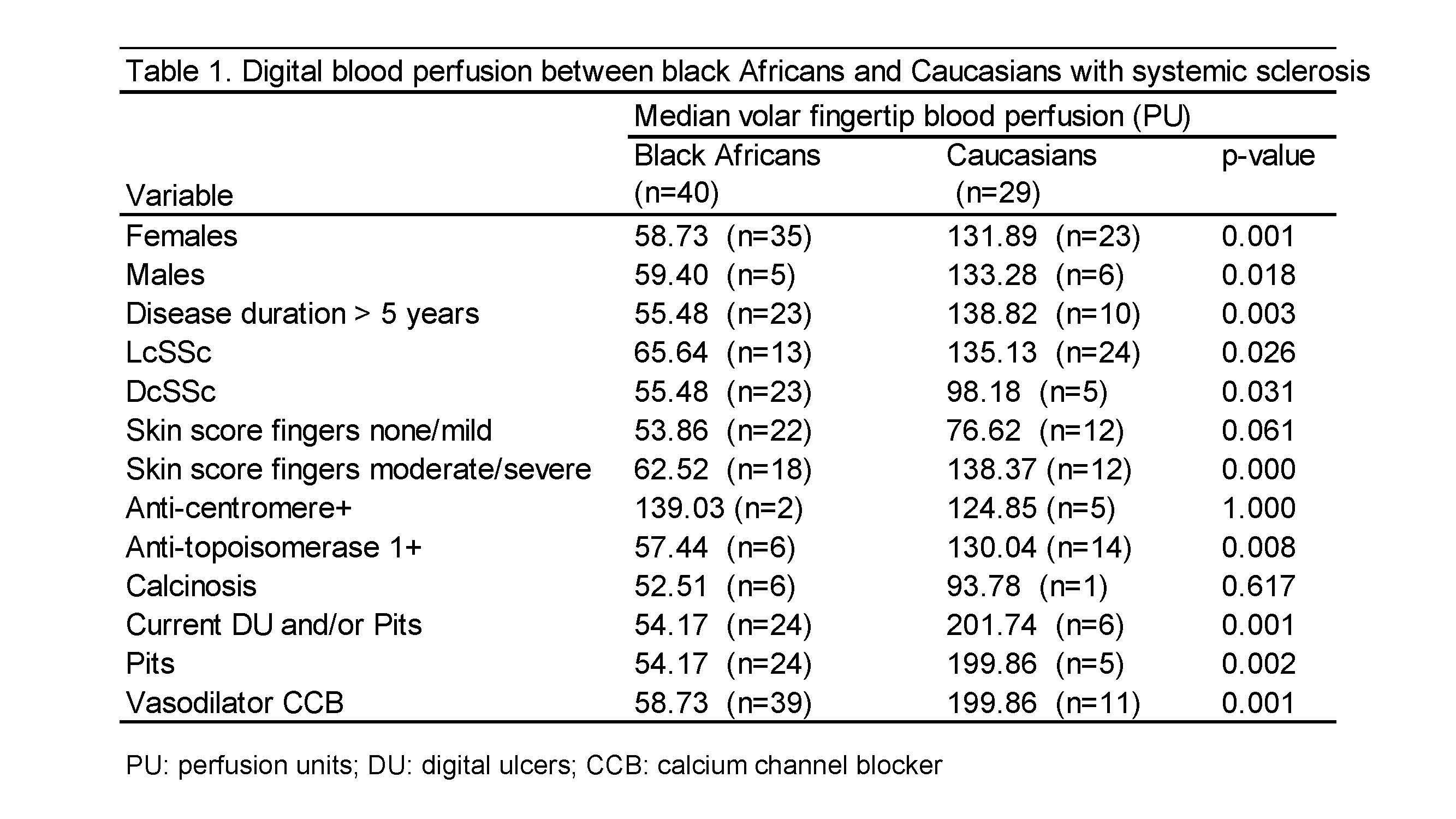Session Information
Session Type: Poster Session (Sunday)
Session Time: 9:00AM-11:00AM
Background/Purpose: Microvascular dysfunction is a prominent feature in SSc. Laser speckle contrast analysis (LASCA) has been shown to be a reliable tool to quantify skin blood perfusion (BP) in SSc (1,2). Patients of African descent have a more severe disease burden than their European counterparts (3). Data are lacking on race/ethnic related differences in peripheral BP measured by LASCA in SSc. The objective of this study was to assess and compare BP at the level of fingertips between black Africans and Caucasians.
Methods: Forty black Africans and 29 Caucasian consenting patients fulfilling 2013 ACR/EULAR classification criteria for SSc were enrolled at 2 different geographic sites. Cutaneous BP in the hands was assessed by LASCA, calculating flows in regions of interest created at the 2-5 volar and dorsal fingertips (4). Standardized protocols for instrumental, environmental and patient conditions were applied at both study sites (1). Median BP was reported as perfusion units (PU).
Results: With respect to demographic and clinical characteristics, the significant differences between the 2 cohorts were that blacks were younger (mean age 48.5±9.9 vs 55.5±12.3 years, p=0.01), had a longer disease duration (mean 9.2±7.1 vs 5.8±6 years, p=0.04), a greater proportion of the diffuse cutaneous disease (67.5% vs 17.2%, p< 0.001), and were more likely to be on vasodilator calcium channel blocker therapy (97.5% vs 37.9%, p< 0.0001), compared to Caucasians. In both groups the median BP values were significantly higher for the volar fingertips compared to dorsal fingertips (Blacks: 59.07 vs. 37.39 PU, p=0.0002; Caucasians: 131.89 vs. 96.64 PU, p=0.03). Table 1 shows the univariate analysis comparing the groups with respect to demographics, disease subsets, autoantibodies and selected clinical features in relation to volar fingertip BP measured by LASCA. Overall, the average BP was significantly lower in blacks compared to Caucasians (59.07 vs. 131.89, p=0.0001). Multivariable analysis showed that when using Caucasian females as the referent group, black females and males has significantly lower digital BP (t= -3.86, p< 0.0001; t= -2.93, p=0.005, respectively), with black females showing the lowest BP.
Conclusion: This study shows better BP at the volar fingertips compared to the dorsal fingertips in both groups. We found several differences in digital BP between blacks and Caucasians with SSc. Caucasian females had the best BP and black females had the most impaired digital BP. These racial differences in peripheral BP warrant further investigation of possible ethnic differences in endothelial function.
References: 1) Lambrecht V, et al. Ann Rheum Dis 2016; 75: 1263-64. 2) Cutolo M, et al. Autoimmunity Reviews 2018; 17: 775-80. 3) Morgan ND, et al. Medicine 2017; 96 (51). 4) Ruaro B, et al. Ann Rheum Dis 2014; 73: 1181-85
To cite this abstract in AMA style:
Ickinger C, Lambrecht V, Musenge E, Tikly M, Cutolo M, Smith V. Digital Blood Perfusion Differences Between Black Africans and Caucasians with Systemic Sclerosis [abstract]. Arthritis Rheumatol. 2019; 71 (suppl 10). https://acrabstracts.org/abstract/digital-blood-perfusion-differences-between-black-africans-and-caucasians-with-systemic-sclerosis/. Accessed .« Back to 2019 ACR/ARP Annual Meeting
ACR Meeting Abstracts - https://acrabstracts.org/abstract/digital-blood-perfusion-differences-between-black-africans-and-caucasians-with-systemic-sclerosis/

